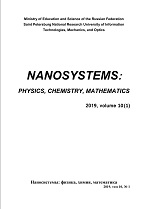|
This article is cited in 1 scientific paper (total in 1 paper)
PHYSICS
Electronic transport in penta-graphene nanoribbon devices using carbon nanotube electrodes: A computational study
M. Shunaid Parvaizab, Khurshed A. Shaha, G. N. Darb, Sugata Chowdhuryc, Olasunbo Farinrec, Prabhakar Misrac
a Department of Physics, S. P. College Campus, Cluster University, Srinagar, J&K-190001, India
b Department of Physics, University of Kashmir, Srinagar, J&K-190006, India
c Department of Physics and Astronomy, Howard University, Washington, DC 20059, USA
Abstract:
Electronic transport properties of pristine, homogenously and heterogeneously boron-nitrogen doped saw-tooth penta-graphene nanoribbon (SPGNR) with carbon nanotube electrodes have been studied using Extended Huckel Theory in combination with the non-equilibrium Green's function formalism. CNT electrodes produce a remarkable increase in current at higher bias voltages in pristine SPGNR. The current intensity is maximum at higher bias voltages, while the nitrogen-doped model shows current from the onset of the bias voltage. However, there are also considerable differences in the I-V curves associated with the pristine model and other models doped homogenously as well as heterogeneously with boron and nitrogen. The doped models also exhibit a small negative differential resistance effect, with much prominence in the nitrogen-doped model. In summary, our findings show clearly that doping can effectively modulate the electronic and the transport properties of penta-graphene nanoribbons that have not been studied and reported thus far.
Keywords:
penta-graphene nanoribbon, CNT, NEGF, EHT, doping, ATK.
Received: 10.03.2020
Revised: 23.03.2020
Citation:
M. Shunaid Parvaiz, Khurshed A. Shah, G. N. Dar, Sugata Chowdhury, Olasunbo Farinre, Prabhakar Misra, “Electronic transport in penta-graphene nanoribbon devices using carbon nanotube electrodes: A computational study”, Nanosystems: Physics, Chemistry, Mathematics, 11:2 (2020), 176–182
Linking options:
https://www.mathnet.ru/eng/nano512 https://www.mathnet.ru/eng/nano/v11/i2/p176
|

| Statistics & downloads: |
| Abstract page: | 82 | | Full-text PDF : | 46 |
|




 Contact us:
Contact us: Terms of Use
Terms of Use
 Registration to the website
Registration to the website Logotypes
Logotypes








 Citation in format
Citation in format 
